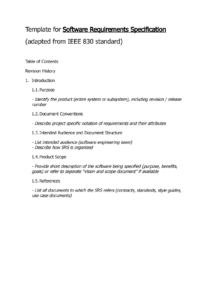When developing software, it is important to first define the functional requirements of the system. These requirements describe the functions that the system must perform, and they serve as the basis for all subsequent development activities.
A well-written functional requirements document will help to ensure that the developed system meets the needs of the users. It will also help to avoid misunderstandings and rework during the development process.
Elements of a Functional Requirements Template
A functional requirements template typically includes the following elements:
- System overview: This section provides an overview of the system, including its purpose and scope.
- Functional requirements: This section lists the specific functions that the system must perform.
- Non-functional requirements: This section lists the non-functional requirements of the system, such as performance, security, and reliability.
- Acceptance criteria: This section defines the criteria that must be met in order for the system to be considered acceptable.
- Glossary: This section defines any terms that are used in the document.
Example of a Functional Requirements Template
The following is an example of a functional requirements template:
System overview
The purpose of this system is to provide users with a way to track their expenses. The system should be easy to use and should allow users to track expenses by category, date, and amount.
Functional requirements
- The system shall allow users to add new expenses.
- The system shall allow users to edit existing expenses.
- The system shall allow users to delete existing expenses.
- The system shall allow users to view a list of all expenses.
- The system shall allow users to view a list of expenses by category.
- The system shall allow users to view a list of expenses by date.
- The system shall allow users to view a list of expenses by amount.
- The system shall allow users to export a list of expenses to a CSV file.
- The system shall allow users to import a list of expenses from a CSV file.
Non-functional requirements
- The system shall be easy to use.
- The system shall be reliable.
- The system shall be secure.
- The system shall be performant.
Acceptance criteria
- The system shall be considered acceptable if it meets all of the functional requirements.
- The system shall be considered acceptable if it meets all of the non-functional requirements.
- The system shall be considered acceptable if it is easy to use.
Glossary
- Expense: A cost incurred by the user.
- Category: A classification of an expense.
- Date: The date on which the expense was incurred.
- Amount: The amount of the expense.
- CSV file: A comma-separated value file.
This is just a simple example of a functional requirements template. The specific template that you use will vary depending on the specific needs of your project.
Conclusion
A well-written functional requirements document is essential for the successful development of any software system. By taking the time to define the functional requirements of your system, you can help to ensure that the developed system meets the needs of the users and that it is developed on time and within budget.
There are many different resources available to help you write a functional requirements document. You can find templates, examples, and guidance from a variety of sources. By using these resources, you can create a document that will help you to develop a successful software system.

